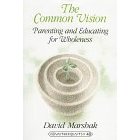 David Marshak, emeritus professor in the College of Education at Seattle University, has written a book, The Common Vision: Parenting and Educating for Wholeness (Peter Lang Publishing), that integrates the developmental ideas of three esoteric thinkers from the early 20th century: Rudolf Steiner, Hazrat Inayat Khan, and Sri Aurobindo. As the title indicates, Marshak examines the common threads that run through these visionaries work when it comes to the education of the child. Each of the three believed that the child was more than a physical body, but also inhabited other planes of existence. Although they gave different names to those planes, they ultimately agreed on the essentials related to these three major non-physical planes of existence that interpenetrate the physical: a vital plane of life-force, a higher plane of mental existence, and a still higher plane that exists at the level of spirit.
David Marshak, emeritus professor in the College of Education at Seattle University, has written a book, The Common Vision: Parenting and Educating for Wholeness (Peter Lang Publishing), that integrates the developmental ideas of three esoteric thinkers from the early 20th century: Rudolf Steiner, Hazrat Inayat Khan, and Sri Aurobindo. As the title indicates, Marshak examines the common threads that run through these visionaries work when it comes to the education of the child. Each of the three believed that the child was more than a physical body, but also inhabited other planes of existence. Although they gave different names to those planes, they ultimately agreed on the essentials related to these three major non-physical planes of existence that interpenetrate the physical: a vital plane of life-force, a higher plane of mental existence, and a still higher plane that exists at the level of spirit.
Each of these thinkers (along with their followers), developed a comprehensive rationale for educating children according to these different planes of existence, and also according to their developmental level. Marshak does an excellent job of explicating in meticulous detail these developmental theories, showing differences as well as similarities. He also grounds the ideas of each of the three thinkers in special chapters that show how the ideas have been applied in concrete learning environments.
For Steiner’s ideas, he visits a second grade classroom at a Waldorf School (a system of education Steiner developed in the 1920’s and which still exists in the U.S. and around the world today). To show Aurobindo’s ideas in action, Marshak travels to India and visits the Sri Aurobindo Ashram, giving details of the children’s school established there. Finally, Marshak interviews Murshida Vera Corda, a follower of the Sufi musician and mystic Hazrat Inayat Khan, who describes the Sufi Seed Center, a school for children based on his principles that ran in San Francisco from the late 1960’s to the early 1980’s.
Marshak’s book integrates a huge amount of information from the voluminous writings of these three thinkers, and saves readers a lot of time from having to find often hard-to-obtain publications, and synthesizes it in a way that can provide practical strategies for parents and educators seeking to help their children learn. What Marshak emphasizes, perhaps more than anything else, is that the child has an “inner teacher” that is the source of inner motivation and learning, and that this inner teacher cannot be forced or manipulated into action, but rather trusted, listened to, and awakened by the outer teacher as facilitator and role model.
Marshak’s book is a great contribution to the literature on child education, and provides a positive counterpoint to the usual “kill and drill” or “testist, bestist, westist” approach to learning that seems to predominate, especially in the United States, at this particular time in history. Each of these three thinkers provided a view of life that extended far beyond education, but Marshak has done the work of focusing attention on their views regarding the practical aspects of parenting and educating children, so that we can all benefit from the wisdom of these pragmatic mystics.
For a psycho-spiritual survey of the entire human life cycle, see Thomas Armstrong, The Human Odyssey: Navigating the Twelve Stages of Life<(Ixia Press, 2019)
This article was brought to you by Thomas Armstrong, Ph.D. and www.institute4learning.com.
Follow me on Twitter: @Dr_Armstrong
.



















